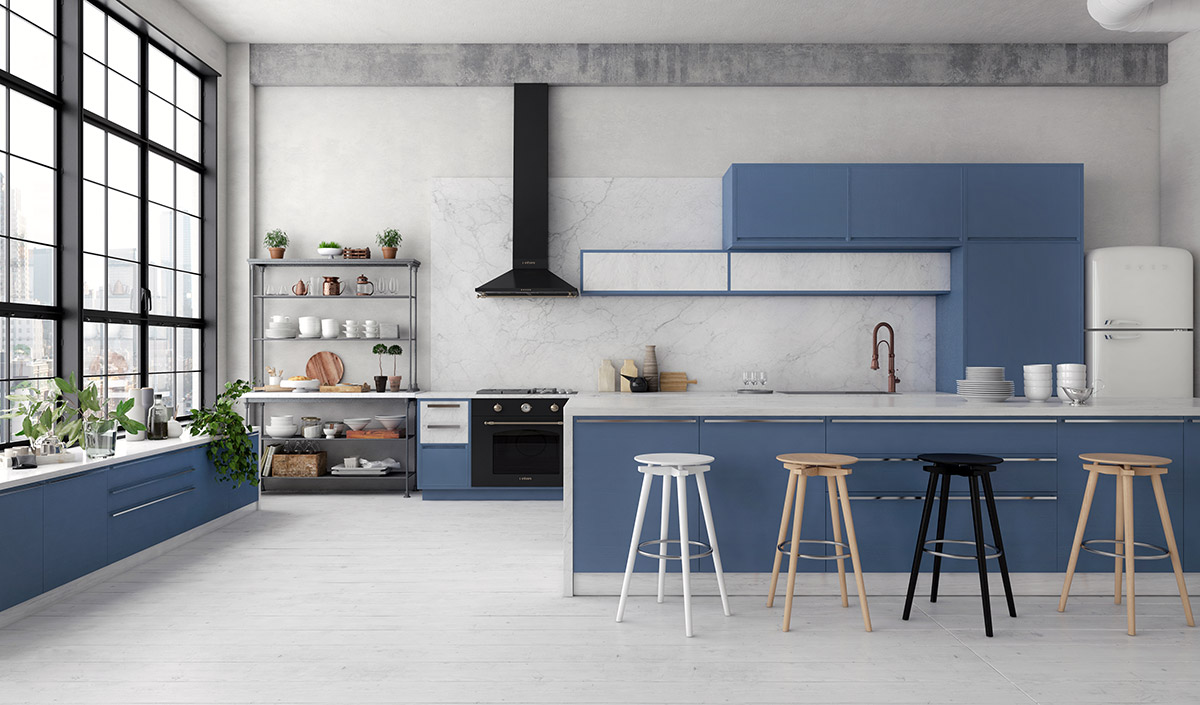
Things to consider when choosing the right Modular kitchen floor
Choosing the correct cabinets, appliances, and countertops is definitely at the top of your list if you’re doing a kitchen makeover or beginning from scratch. However, in order for your kitchen design to work as a complete, you’ll need to know how to choose kitchen flooring. Because the floor of your kitchen is likely to be one of the room’s larger surfaces, it demands careful consideration.
Take the style and substance of your cabinets into account when choosing flooring for your kitchen. Modern plans will benefit from materials like sturdy laminate and matt porcelain, while traditional design would benefit from natural stone tiles and warm wood. Polished concrete is a popular contemporary flooring material that has a stylish, industrial feel to it.
Apart from providing durability and practicality, your kitchen flooring also serves as a vital design statement for your kitchen décor. With the variety of materials, colors, patterns, and textures available today, you have an almost limitless number of options for kitchen flooring. Let’s look at some of the most popular and long-lasting kitchen flooring options Listed by LeFreddo- designer of the best Modular kitchen in Salem.
SELECT EASY-TO-CARE-FOR KITCHEN FLOOR TILES
Nothing beats floor tiles as one of the greatest kitchen flooring options for durability and a variety of decorative impacts. From textured to matt to high gloss, floor tiles are available in a variety of natural and artificial materials and finishes. Some tiles are more permeable than others, which is something to keep in mind in a room with a lot of dampness.
Some flooring need resealing and treatment with specialized solutions on a regular basis. Consider whether you’ll have time to maintain your kitchen floor or if you’d rather use a low-maintenance material that you can sweep, mop, and forget about. In an open kitchen space, don’t be scared to mix materials. It is better to, use tough, easy-to-clean flooring in the kitchen, while in the living and dining areas, use softer vinyl, laminate, or wood.
- Because limestone is porous, it must be sealed both when it is installed and once for twice a year.
- Although factory-pretreated wood flooring is a long-lasting option, it must be resealed every five to six years.
- Concrete flooring (which is a popular choice these days) requires little to no upkeep.
- If you choose tiles, you’ll need to clean and seal the grout on a regular basis to avoid stains.
Of course, we can’t advise you how to choose your kitchen flooring because it all relies on your lifestyle and demands. However, you should consider the cost of repair and maintenance before making your decision.
Consider the Style
While durability is vital when choosing kitchen flooring, your own style should be considered as well. Select a flooring option that blends well with the rest of your kitchen’s decor. Don’t forget about flooring while choosing the design, color scheme, look, and feel of your kitchen. Is the flooring you’ve chosen compatible with the colors you’ve chosen for your walls, cabinets, and counters? Does it blend well with your kitchen’s diverse textures and patterns?
Decide whether your kitchen floor will be a focal point (think black and white checkered tiling) or a neutral backdrop (soft beige, off white, or grey). If you’re going for a dramatic kitchen flooring decision, make sure it won’t bore you in a few months or even years.
Durability
Consider the types of things your floor will have to withstand over time (child and pet accidents, excessive traffic, etc.) when choosing your kitchen flooring. When choosing kitchen flooring, keep the following points in mind:
- Nonslip floors are a vital safety element if you have young children or elderly people in your home.
- Consider stone and tile, which are both durable, if your kitchen is a high-traffic area.
- Ceramic tile, which resists dents and scratches, could be a suitable choice if you anticipate a lot of dropped pots and pans or other significant usage.
- The fact that there will be a lot of foot traffic and the possibility of water stains does not mean you should avoid using wood. Both can be tolerated by prefinished wood flooring.
- Choose a flooring type that can tolerate muddy boots and shoes, as well as damp towels and feet, if your kitchen is adjacent to a garage or pool.
Affordable
Luxury kitchen flooring might cost higher for per square foot, but if you shop around and do the installation yourself, a new kitchen floor can be very low. However, that cost isn’t the only factor to consider the material must also be for your cook space. Here we have listed a few affordable flooring options
- Vinyl: Durable, water resistant and lasts up to 25 years. It requires less maintenance daily sweeping and mopping is more than enough.
- Sheet Vinyl: When it comes to design, texture, and quality, this cut-to-length alternative has come a long way. Sheet vinyl is commonly available in 6′ and 12′ widths, making it heavy and difficult to handle. It is best left to the pros to install.
- Plank Vinyl: Prices vary depending on whether you choose an engineered vinyl plank (EVP), a luxury vinyl plank (LVP), a waterproof vinyl plank (WVP), or a stone composite variant (SVP), which is great for high-traffic areas.
- Laminate: In terms of cost, laminate is equivalent to vinyl sheets; however, it is not as robust as vinyl, should not be subjected to heat, is not waterproof, and has a 10-year lifespan.
- Tile: Both Ceramic tile and porcelain tile make an excellent inexpensive flooring option for any kitchen.
